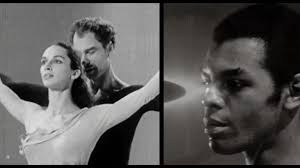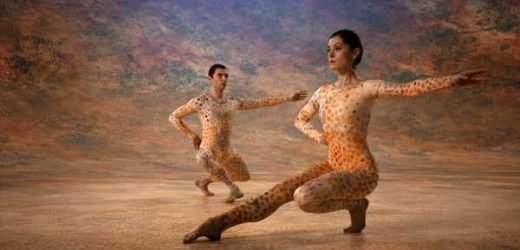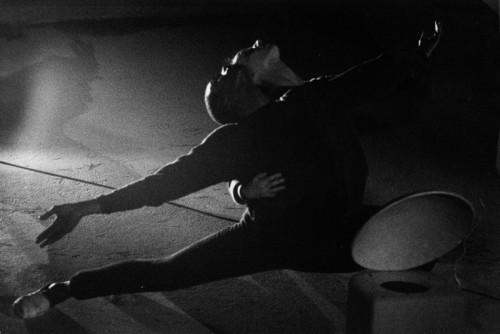ALLA KOVGAN: CUNNINGHAM (3D 2019) Portrait of the artist as a tireless iconoclast
Portrait of the artist as a tireless iconoclastEarlier this year there were two films, the found and restored 58-minute 1968
Assemblage, and a new 83-minute one,
If the Dancer Dances depicting the painstaking recreation of a Cunningham production,
both of which are invaluable close looks at the work of the choreographer Merce Cunningham. Now comes
Cunningham, 93 minutes, a bigger, more sweeping portrait of the artist and his work. He is a towering figure of modern dance who was active for seventy years, up to his death at 90 in 2009. Formally inventive, this impressive new film, inspired by Wim Wenders' much admired 2011 film
Pina about Pina Bausch, uses 3D and multiple split screen images and provides a lively mixture of archival footage and new recreations of some of Merce's key works, his 100 dances and 700 events - or, the
Wikipedia article says, 200 dances and 800 events - a monumental body of work, in any case, and too little known.
Once I saw the company perform, in Berkeley. I expected it to be an off-putting experience, but it was surprisingly accessible, and enjoyable. It was one of their many collaborations, this time with the Kronos Quartet and Salmon Rushdie. At the end of it, Merce came out to take a bow, walking slowly but magisterially, with two canes, his body apparently wrecked from his hard dancing life. The shorter films showed certain key aspects of his work that are borne out here. He seems almost not to care for music, nor yet for sets and costumes, or even, the way he tells it at times, for ideas or themes.
Of course his company's dances had all these. But he notoriously rehearsed them with a stopwatch, in silence, only counting. He clearly saw dance as separate from music, however essential it might be to have the melodies of Frédéric Chopin orchestrated by Alexander Glazunov for us to enjoy
Les Sylphides. How perfect, then, that he should have found a collaborator and a lover in John Cage, the composer of silence. In this film Merce repeatedly rejects his dances being "about" something. What they're about, he says, is for the audience to decide, and each of its members will decide differently what that is.
At the same time, one of the dancers says Merce's claim that the dances were "just steps" wasn't remotely true. What emerges here is that there was usually a very clear thematic focus pointing to certain themes, but leaving one open to various interpretations. Take one of the first dances recreated here, the 1958
Summerspace. Here it's staged outdoors, with what, as Merce pointed out caused dancers' complaints, lots of spinning. The
New York Times dance writer Alastair Macaulay calls
Summerspace "pure dance that evokes the ways of nature and wildlife."
One is dumbstruck by the timely, evocative
Winterbranch (1964), with dancers moving in darkness and spotlights flickering over them. It's said to be "all about violence" and that it has evoked variously concentration camps, race riots, atomic bombs. To me it seemed clearly to show highway accidents with people run over, and the sound design/score seemed to mimic that. In any case, it's surprisingly contemporary, a shocking, evocative, and exhilarating work. Originally it was lit by Robert Rauschenberg, using a computer system ramdomly.
Rauschenberg was a key collaborator. Lack of fame and lack of money united them initially, Merce says. When Rauschenberg won a big prize and became very famous and busy, he walked away from his collaboration. Another collaborator was Jasper Johns. Cage, Cunningham, Rauschenberg, Johns made a powerful gay mafia of art. Later, Warhol came in with his floating silver pillows for another notable Cunningham dance (focused on in
If the Dancer Dances)
Rainforest, its costumes consisting of distressed tights originally designed by Jasper Johns. All these famous Merce Cunningham pieces are handsomely recreated for this new film.
"How do you make a moment alive, technique or not?" we hear Merce say. "How do you keep in the daring, however long practiced and repeated, that spontaneous act the stance of a cat can give you?" Ah, yes, the stance of a cat. It seems hard to describe the Merce Cunningham style, notable for its variety and invention, but it never ceases to feel alive here.
The film particularly focuses on one major event in the company's performing life: a 1964 tour that included many countries, among them Paris, where they were booed, and London, where they were a great sensation and held over. "Merce screwed up and they liked us," a collaborator quips. This success revised their reputation and enlarged their audience.
Merce himself is heard from a lot in
Cunningham but doesn't necessarily get the last word. Some female members of the company are heard to complain that they were always in secondary positions in his dances. They also say, as does he, that he originally recognized the individuality of the members of the company; that on principle, he did not try to "correct" their individual peculiarities or make them uniform. But once all the original members had left, Merce began to see the company members more collectively, and we are shown dances to illustrate that, where the dancers are moving around together like a
corps de ballet and Merce is using them more as a group. Initially, he has been quoted saying that he loved what (classical) ballet did with the legs, and admired what modern dance did with the torso and therefore set out to combine these two elements. Could this be one reason why the company's style seems hard to pigeonhole and less tied to the quirks of modern dance?
After Merce Cunningham's death in 2009, following his instructions the company was disbanded. But a trust was formed to perpetuate his artistic legacy. This excellent film is further evidence that that legacy lives on, keeping the "daring, however long practiced and repeated." If you watch
If the Dancer Dances, you will see how fleeting and complex is a style of dance and how hard it can be to recover it. But you can do it. Dance is beautiful to watch, and endlessly hard work to create, but it is timeless.
Cunningham, 93 mins., debuted at Toronto, and was included thereafter in 18 other festivals. Its limited US theatrical release by Magnolia, in 2D, 3D and RealD 3D, begins Dec. 13, 2019 in New York and Los Angeles, and in the Bay Area Jan. 3 (Embarcadero, San Francisco; Shattuck, Berkeley).
Cunningham TRAILER.
 SUMMERSPACE
SUMMERSPACE WINTERBRANCH
WINTERBRANCH





